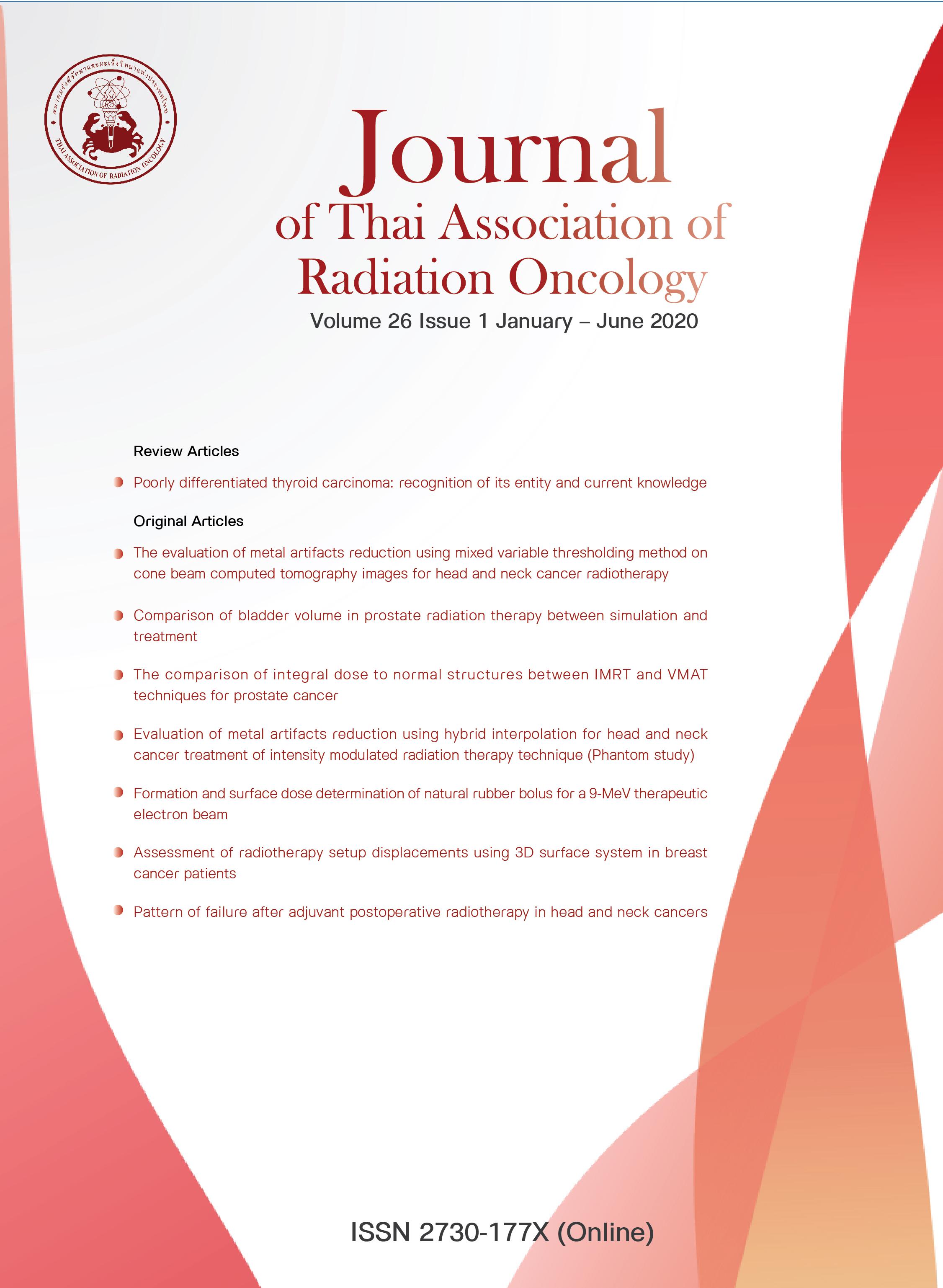Comparison of bladder volume in prostate radiation therapy between simulation and treatment
Keywords:
Prostate cancer, bladder filling, uncertaintyAbstract
Background: Bladder filling uncertainties during prostate irradiation has direct effect on bladder dose.
Objective: To compare bladder volume between computed tomography (CT) simulation day and during radiotherapy.
Materials and Methods: The bladder volume of 9 prostate cancer patients who underwent irradiation with Varian TrueBEAM (Varian Medical System. Inc., Palo Alto, CA) at King Chulalongkorn Memorial Hospital were evaluated. Patients were required to empty their bladder before starting to record the bladder filling times. The time was recorded until treatment delivery. Patients had to drink 500 ml of water while waiting for the treatment. The dimension of bladder volume in width, length, and height was measured and calculated to bladder volume by using ellipsoid formula (width´length´height´0.52) on planning CT and daily Cone Beam Computed Tomography (CBCT) images by experience radiation technologists. The comparison of bladder volume was evaluated.
Results: The average time for bladder filling was 117.4 ± 3.7 minutes. The result showed that the bladder volume of CBCT on the treatment date was less than the bladder volume of planning CT significantly. The bladder volume was 455.3 ± 205.7 and 419.1 ± 197.5 cm3 for planning CT and CBCT, respectively.
Conclusion: The bladder volume for prostate cancer in the delivery process of radiotherapy was significantly less than on planning CT, which may be due to less amount of water or waiting time was not enough.
References
Sittiporn Srinualnad M, Uiprasertkul M, Amornvesukit T, Taweemonkongsap T, Nualyong C, Tantiwong A. Prevalence of prostate cancer in aging males receiving PSA (prostate specific antigen) screening test (A campaign for celebration of Siriraj Established Day). J Med Assoc Thai. 2006;89:37-42.
ทวีป แสงแห่งธรรม. ระบบภาพในงานรังสีรักษา. J Med Assoc Thai. 2016;22:16-23.
Gill S, Thomas J, Fox C, Kron T, Rolfo A, Leahy M, et al. Acute toxicity in prostate cancer patients treated with and without image-guided radiotherapy. Radiat Oncol. 2011;6:145.
Maggio A, Gabriele D, Garibaldi E, Bresciani S, Delmastro E, Di Dia A, et al. Impact of a rectal and bladder preparation protocol on prostate cancer outcome in patients treated with external beam radiotherapy. Strahlenther Onkol. 2017;193:722-32.
Mullaney LM, O’Shea E, Dunne MT, Finn MA, Thirion PG, Cleary LA, et al. A randomized trial comparing bladder volume consistency during fractionated prostate radiation therapy. Pract radiat oncol. 2014;4:e203-e12.
Miralbell R, Özsoy O, Pugliesi A, Carballo N, Arnalte R, Escudé Ls, et al. Dosimetric implications of changes in patient repositioning and organ motion in conformal radiotherapy for prostate cancer. Radiother oncol. 2003;66:197-202.
Siow T, Ngoi C, Tan W. Inter-fraction prostate motion during intensity-modulated radiotherapy for prostate cancer. Singapore Med J. 2011;52:405-9.
Pinkawa M, Asadpour B, Siluschek J, Gagel B, Piroth MD, Demirel C, et al. Bladder extension variability during pelvic external beam radiotherapy with a full or empty bladder. Radiother oncol. 2007;83:163-7.
Nakamura N, Shikama N, Takahashi O, Ito M, Hashimoto M, Uematsu M, et al. Variability in bladder volumes of full bladders in definitive radiotherapy for cases of localized prostate cancer. Strahlenther Onkol. 2010;186:637-42.
Dicuio M, Pomara G, Fabris FM, Ales V, Dahlstrand C, Morelli G. Measurements of urinary bladder volume: comparison of five ultrasound calculation methods in volunteers. Arch Ital Urol Androl. 2005;77:60-2.
Sithamparam S, Ahmad R, Sabarudin A, Othman Z, Ismail M, editors. Bladder filling variation during conformal radiotherapy for rectal cancer. Journal of Physics: Conference Series; 2017: IOP Publishing.
Waddle MR, Landy R, Ryan K, Tzou KS, Stross WC, Kaleem T, et al. Bladder filling during radiation therapy for prostate cancer treatment: Assessment via bladder ultrasound scanner. J Clin Oncol; 2018;36:6_suppl, 147-147
Chanayota J, Suriyapee S, Alisanant P, Sanghangthum T, editors. Dosimetric comparison between using daily cone beam CT and planning CT in Volumetric Modulated Arc Therapy technique for prostate cancer therapy. Journal of Physics: Conference Series; 2019: IOP Publishing.
Moiseenko V, Liu M, Kristensen S, Gelowitz G, Berthelet E. Effect of bladder filling on doses to prostate and organs at risk: a treatment planning study. J Appl Clin Med Phys. 2007;8:55-68.
Chen Z, Yang Z, Wang J, Hu W. Dosimetric impact of different bladder and rectum filling during prostate cancer radiotherapy. Radiat Oncol. 2016;11:103.
Zellars RC, Roberson PL, Strawderman M, Zhang D, Sandler HM, Ten Haken RK, et al. Prostate position late in the course of external beam therapy: patterns and predictors. Int J Radiat Oncol Bio Phys. 2000;47:655-60.
Downloads
Published
How to Cite
Issue
Section
License
บทความที่ได้รับการตีพิมพ์เป็นลิขสิทธิ์ของวารสารมะเร็งวิวัฒน์ ข้อความที่ปรากฏในบทความแต่ละเรื่องในวารสารวิชาการเล่มนี้เป็นความคิดเห็นส่วนตัวของผู้เขียนแต่ละท่านไม่เกี่ยวข้องกับ และบุคคลากรท่านอื่น ๆ ใน สมาคมฯ แต่อย่างใด ความรับผิดชอบองค์ประกอบทั้งหมดของบทความแต่ละเรื่องเป็นของผู้เขียนแต่ละท่าน หากมีความผิดพลาดใดๆ ผู้เขียนแต่ละท่านจะรับผิดชอบบทความของตนเองแต่ผู้เดียว




